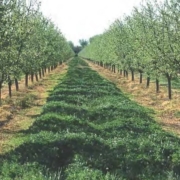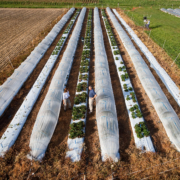The Demise and Hope of Whole-Farm Revenue Protection
 Print This Post
Print This Post
By Jeff Schahczenski, Agriculture and Natural Resource Economist
“Man is certain of nothing but his ability to fail.”
—Ken Kesey, from his novel Sometimes a Great Notion
Sometimes a great notion is not enough. Working 18 years trying to improve the sustainability of agriculture through the promotion of a novel federal crop insurance policy called Whole-Farm Revenue Protection (WFRP) remains a great notion, but one I fear that has been doomed to failure. Indeed, the way crop insurance is generally structured today more greatly inhibits the development of sustainable agriculture than one might suspect.
As my long-time Montana organic farmer friend, Doug Crabtree of Vilicus Farms, has said, “crop insurance as it currently operates is the biggest perversion to the possibility of truly sustainable agriculture.”
Yet at the same time, Doug freely admits that without crop insurance in the harsh, semi-arid ecology of the northern Great Plains, he would be bankrupt. Why such a dependence on crop insurance? Why the demise of the great notion of WFRP?
I was first introduced to WFRP at the annual meeting of the Montana Farmers Union in 2004. Then, the product had two names—Adjusted Gross Revenue (AGR) and Adjusted Gross Revenue Lite (AGR-lite)—and even then, the details of the policy were confusing, although the idea was simple. Based on the average of a farmer’s five-year gross revenue history documented in his tax records, subsidized insurance would be offered that would provide an indemnity payment up to 85% of that estimated average revenue history. Given the economic capacity of the farm to generate revenue, should the entire revenue be wiped out either by multiple perils or market forces, the farmer would be protected from complete failure.
In addition to the protection from yield and product price losses, if the farmer was diversified in crop and livestock production, the cost of the insurance declined, thus providing an incentive for sustainable diversification. Finally, it was a policy that could apply to all types and scales of farms because it was independent of what one produced and thus provided good revenue protection to all of agriculture rather than to mostly those who only grow major commodity crops.
So here we had insurance for the farmer that let the farmer decide what crops and livestock products to produce that he/she thought would provide the greatest return, encouraged diversification of their production system, and was potentially available to all.
What is truly special about this simple idea is that it had the potential to supplant the limitations of single-commodity crop revenue-protection insurance that offers such great coverage that it has made growing such crops as corn and soybeans almost riskless. The near riskless nature of growing these commodity crops encourages the monocultures across great expanses of our agriculture landscape. Clearly unsustainable.
The notion largely failed because the federal Risk Management Agency, which administers all federal crop insurance, in conjunction with the 13 Approved Insurance Providers (AIPs), made the application more and more onerous, demanded tracking of farm’s historic expenses (something that no other crop-insurance policy requires), and required ever more detailed production and sales records, in addition to tax records, so that even crop insurance agents did not want to write the policies and became ever fearful of messing it up.
WFRP is still available but is being used at a declining rate. Last year, only 1,935 WFRP policies were sold. I would suggest that despite its minimal impact on American agriculture, the great notion of WFRP is failing because the political and economic forces did not and do not want to change the current system that supports the overproduction of a few commodity crops, which benefits those who sell inputs into those systems and those who want to buy and re-sell this output at the lowest cost possible.
For me, hope springs eternal and there is always another Farm Bill. Even though our capacity to fail is ever present, with time and thought, we can improve.
Related ATTRA Resources:
Crop Insurance and Risk Management
Episode 266. The Hopes and Challenges of Crop Insurance
This blog is produced by the National Center for Appropriate Technology through the ATTRA Sustainable Agriculture program, under a cooperative agreement with USDA Rural Development. ATTRA.NCAT.ORG.

 USDA
USDA









